ARTHUR EVANS
AND THE PALACE OF MINOS
In 1878, minor excavations at the site of Kefala Hill (the site of the Palace at Knossos) on Crete undertaken by a man named Minos Kalokairinos from nearby town of Heraklion, had unearthed some fragments of pottery and a clay tablet inscribed with an unknown script. These finds attracted attention and the site was subsequently visited by Heinrich Schliemann. Impressed by what he saw, Schliemann applied successfully to the Turkish governor of Crete for permission to excavate. His attempts to purchase the site, however, were unsuccessful and in 1889 he put the project aside and returned to Troy to conduct further excavations there. The following year Schliemann died.
In 1896, the British archaeologist Arthur Evans (later, Sir Arthur Evans; 1851-1941) managed to acquire part-ownership of the site of Kefala Hill using his own funds. Later, with the help of the Cretan Exploration Fund that he had established, Evans was able to purchase to entire site; excavations began on Friday 23 March 1900. An entry for that day in the day-book of Evans's assistant, Duncan Mackenzie, reads: "The excavations by Mr. Arthur Evans at Knossos began this morning at 11:00 a.m."
 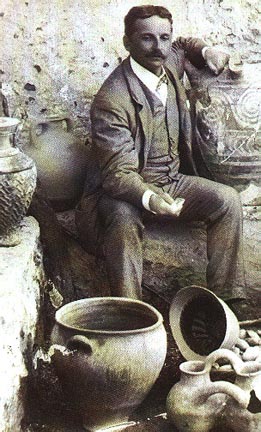
Arthur Evans (1851-1941)
Evans's early archaeological interest had been in coins and engraved gems. Stones engraved with unintelligible 'hieroglyphs' reportedly from Crete had caught his attention, and in 1894 he travelled to Crete to collect more examples. He thought that at the site of Knossos, which had already been partially unearthed in 1878, he could discover more about the origins of the Mycenaeans (recently 'discovered' by Heinrich Schliemann) and the early history of writing. The excavation of the palace at Knossos, which was to occupy him for the rest of his life, uncovered not only more script but also a new civilisation.
During the first season, the excavation uncovered about two acres of the Palace site. The dumping ground chosen for the earth removed was located south and east of the site. As the dig progressed and the size of the palace became apparent, it later became necessary to remove one of the dumps. The site was eventually found to cover 51/2 acres.

Plan of the Palace at Knossos (LM)
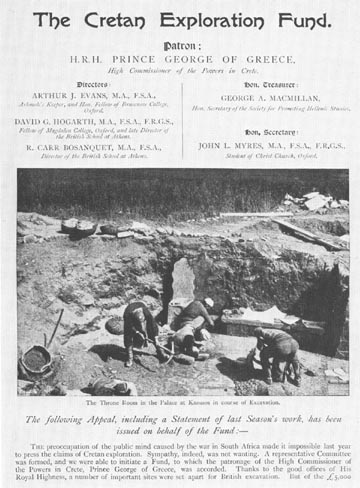
|
The Cretan Exploration Fund
1900
In 1900, the year he began excavating at Knossos, Evans issued an appeal for funds. The Cretan Exploration Fund had been established under the aegis of of the British School of Archaeology in Athens in June 1899.
The brochure for the appeal shows a photograph of the excavations being undertaken in the "Throne Room". The "Throne Room" had been the most dramatic discovery of the first season.

|
The Throne Room
during excavation in 1900
Arthur Evans in the Throne Room shortly after its excavation. Note the remains of paintings on the walls.
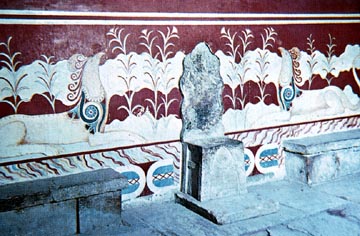
|
The Throne Room Restored
1930
The Swiss artist Emile Gilliéron (1850-1924) was hired by Evans to undertake restoring and painting the reliefs and frescoes. The fragments on the north wall to the right of the throne, Evans identified on April 13 as "palms", but the next day corrected his notation with "No! reeds." When Gilliéron visited the Throne Room on April 18, 1900, he identified parts of seated griffins in the fresco that still adhered to the surface of the west wall. On 13th February 1902, a griffin's paw was identified to the right of the Throne on the north wall. Evans had previously interpreted this as part of an eel. There has been a lot of speculation about the accuracy of the restoration of the frescoes in the Throne Room.
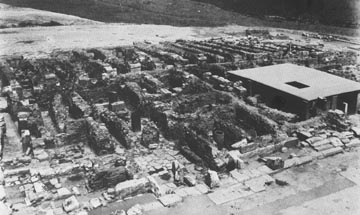
|
View of the West side of the site
Photograph from 1901
In 1901 the Throne Room was covered with a flat roof to protect the gypsum floor, the benches, and the fresco fragments which had not been removed. The photograph also shows the so-called Temple Repositories next to the right the Room of the Tall Pithos (a medallion pithos can be seen still in place). Beyond can be seen the West Magazines.
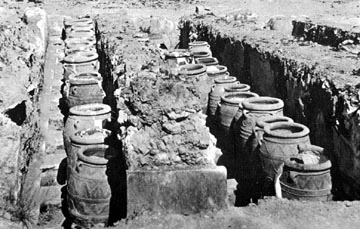
|
View of the West Magazines with pithoi
Photograph from 1901
 The West Magazines are a series of 18 narrow storerooms which bordered the west side of the palace. Huge clay jars called pithoi (sing: pithos) used for storing olive oil, wine, grain, or pulses were found still in place. It is estimated that the average-sized jar held about 35 gallons. The West Magazines are a series of 18 narrow storerooms which bordered the west side of the palace. Huge clay jars called pithoi (sing: pithos) used for storing olive oil, wine, grain, or pulses were found still in place. It is estimated that the average-sized jar held about 35 gallons.
 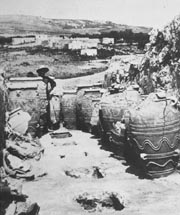
|

|
Restoring the Grand Staircase
probably in 1905
Evans, in the white pith helmet and suit, stands on the third flight of stairs with his assistant Duncan Mackenzie next to him and in front wearing a wide-brimmed hat Christian Doll who was the architect overseeing the task of restorating of the Grand Staircase. In the photograph, the wooden props are being replaced by iron girders.

|
Partially Restored Grand Staircase
1901
This view shows the balustrade of the third flight of the Grand Staircase, with round open sockets ready for columns. The fourth flight was erected in 1902
|
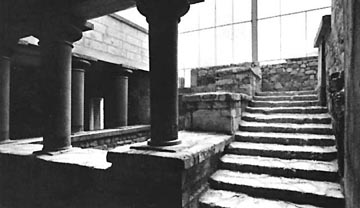
|
|
Grand Staircase Restored
|
| | | | | |
|
|
|

 SPRING 2016
SPRING 2016  SCHEDULE
SCHEDULE  REQUIREMENTS
REQUIREMENTS

 SPRING 2016
SPRING 2016  SCHEDULE
SCHEDULE  REQUIREMENTS
REQUIREMENTS